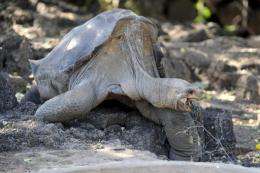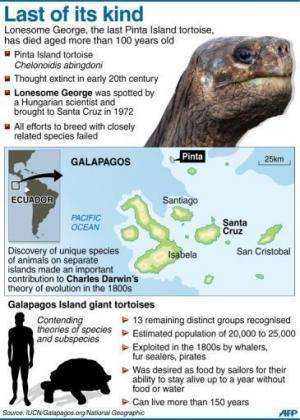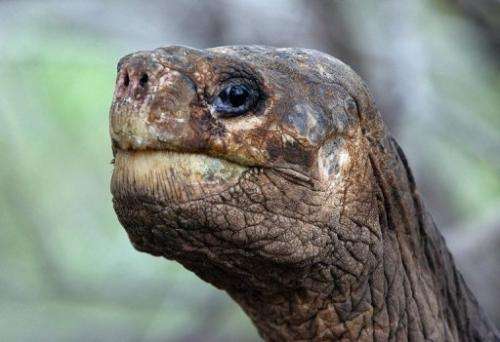Lonesome George, the last known Pinta Island tortoise, seen at Galapagos National Park's breeding center in Puerto Ayora, Santa Cruz island, in 2008. The famed fiant tortoise has died, leaving the world one subspecies poorer.
The death of Lonesome George came as a shock to the caretakers who had come to know the 100-year-old giant tortoise, the last survivor of a subspecies decimated by pirates more than a century ago.
The last remaining Pinta Island giant tortoise and celebrated symbol of conservation efforts in the Galapagos Islands passed away Sunday with no known offspring, his sudden demise a mystery to those who studied and cared for him.
"He was in good condition. On Friday, the last day he fed, he ate normally. There was nothing to suggest that this would occur," biologist Washington Tapia, of the Galapagos National Park, told AFP.
Lonesome George used to eagerly approach his longtime caretaker, Fausto Llerena, the only male the aging and seemingly neurotic tortoise would allow inside his pen on Santa Cruz Island, Tapia said.
"He was a special animal, complex in his behavior," he added.
But on Sunday Llerena found the giant tortoise stretched out facing the direction of his watering hole. The body has since been moved to a cooler to preserve it ahead of a necropsy to determine the cause of death.
Graphic factfile on Lonesome George, the last Pinta Island giant tortoise, who that has died aged more than 100 years old, signalling the extinction of a species.
Lonesome George was discovered on Pinta Island in 1972 at a time when giant tortoises of his type, Geochelone nigra abingdoni, were already believed to be extinct.
Experts estimate there were once some 300,000 giant tortoises on the remote Pacific archipelago, but the species was decimated by pirates in the 18th and 19th century, who hunted them for food and introduced new predators.
After his discovery, Lonesome George became a prized member of the park service's tortoise program, and attempts were made to breed him with rare female tortoises who contained similar genetic material.
The tortoises took things slow -- after 15 years in captivity together Lonesome George mated with one of them, but the eggs were infertile. An attempt at artificial insemination also failed.
But while Lonesome George was unable to save his own kind, the park credits him with spurring efforts to save other endangered species in the archipelago, including other kinds of giant tortoises.
In honor of Lonesome George, it plans to convene an international workshop in July on management strategies for restoring tortoise populations over the next decade.
Lonesome George, the last known Pinta Island Tortoise, subspecies Geochelone nigra abingdoni, is pictured at Galapagos National Park's breeding center in Puerto Ayora, Santa Cruz island, Galapagos in 2006. The death of George came as a shock to the caretakers who had come to know the 100-year-old giant tortoise, the last survivor of a subspecies decimated by pirates more than a century ago.
"Lonesome George's legacy will be an increased effort in both research and management to restore his island of Pinta and all of the other giant tortoise populations of Galapagos," it said.
The Galapagos Islands, situated about 1,000 kilometers (620 miles) off Ecuador's coast, are considered a haven for tortoises.
There are about 20,000 giant tortoises left in the Galapagos, according to the park's website. They are believed to be able to live up to the age of 200, but scientists won't know for sure until they document the life spans of the first generation to be born in captivity, in the 1970s.
The Galapagos gained fame when Charles Darwin visited in 1835 to conduct landmark research that led to his revolutionary theories on evolution.
The archipelago has been a UNESCO World Heritage Site since 1978 for the rich plant and animal life found both on its land and in the surrounding sea.
In 2007, the organization declared the island chain's environment endangered due to the increase in tourism and the introduction of invasive species.
(c) 2012 AFP

























